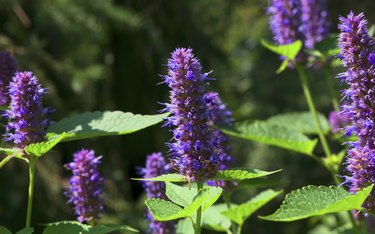
Agastache plants (Agastache spp.), also called hyssops or hummingbird mints, have strongly scented foliage and attractive flowers. They're generally tough, easy-to-grow plants that withstand winter cold well. The group includes anise hyssop (Agastache foeniculum), which grows in U.S. Department of Agriculture plant hardiness zones 6 through 10, Korean hyssop (Agastache rugosa), which grows in USDA zones 5 through 9, and "Blue Fortune" hyssop (Agastache "Blue Fortune"), which is a hybrid of these two species that grows in USDA zones 5 through 10. Although they're all winter-hardy, giving them extra care as cold weather approaches can help them do well the following spring.
Early Preparations
Video of the Day
Hyssops generally flower in summer through early fall, with some varieties blooming slightly earlier or later. As blooming ends, cut off dry flowers to keeps the plant looking tidy. If you grow more than one variety of hyssop, they could cross-pollinate and produce plants different from either parent, but removing spent flowers also prevents self-seeding. Use sharp shears, disinfecting the blades with a cloth soaked in rubbing alcohol between cuts to prevent spread of disease. Keep the plant well-watered from late summer into fall, to allow roots to take up water needed to produce nutrients for storage. Aim for about 1 inch of water weekly, including rain. Don't fertilize the plant late in fall because this stimulates tender new growth that's easily harmed by cold.
Video of the Day
Fall Planning
It's a good idea to cut back the top growth of a hyssop plant once it has dried and the plant has become dormant, because removing old top growth helps prevent diseases that can overwinter on plant debris from reappearing in spring. Cut the plant back to about 3 inches from the ground, to avoid damaging the crowns that are near the soil line. If your area has relatively mild winters and the ground doesn't freeze, continue watering the plant lightly every four to six weeks through fall and winter, because roots can still take up small amounts of water under these conditions. In cold-winter areas, give the plant water whenever a warm spell thaws the ground.
Winter Protection
Adding a protective layer of organic mulch during the winter also helps a hyssop plant survive the cold, but if the ground in your area freezes during winter, wait until several frosts have occurred. Mulching too early can keep the soil warm, allowing the plant to start growing again when it should stay dormant and conserve energy for the next spring, and new growth might freeze and jeopardize the plant's survival. If you spread mulch too early, this can also keep moisture in the soil and encourage root rot, which can lessen the plant's ability to grow in spring. When spring does arrive, remove the mulch gradually as you see new growth appear.
Renewing the Plants
If you've been growing hyssop plants for several years and they've started to decline, fall is a good time to divide a hyssop clump to make new plants. Once foliage is dry and the plant has stopped growing, use a fork or spade to dig up the clump, preserving as many healthy looking, solid and thick roots as possible. Discard any older or weakly growing parts of the clump, cutting these away from healthy areas with a sharp knife that you clean between cuts with rubbing alcohol. Replant the healthy divisions immediately, adding some compost to the soil and watering them in well. If your area experiences long spells of sub-freezing temperatures during winter, you can also wait until early spring to make new divisions, but do so before you see signs that the plant has broken dormancy, such as new shoots or small green leaves.